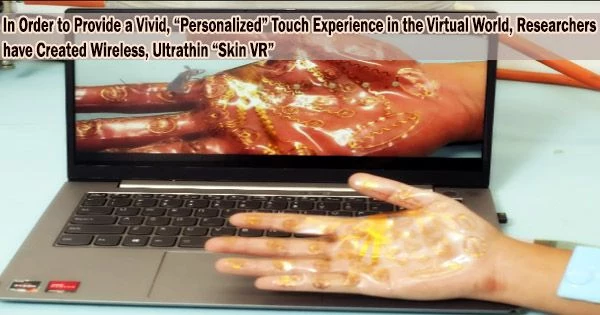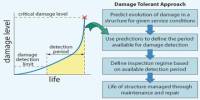Researchers are working on developing more compact and flexible haptic devices that can provide a wider range of sensations. There are also efforts to integrate haptic technology into clothing and other wearable items, which could allow for a more immersive and natural haptic experience.
The use of touch to enhance virtual experiences has gained popularity, although most haptic technology now available is still large and wired up. WeTac is an advanced wireless haptic interface system that is worn on the hand, has soft, ultrathin features, and collects individualized tactile sensation data to deliver a lifelike touch experience in the metaverse. It was recently developed by a team of researchers led by City University of Hong Kong (CityU) researchers.
The technology has the potential to be used for remote robotic controls, games, sports, and skill development.
“Touch feedback has great potential, along with visual and audial information, in virtual reality (VR), so we kept trying to make the haptic interface thinner, softer, more compact and wireless, so that it could be freely used on the hand, like a second skin,” said Dr. Yu Xinge, Associate Professor in the Department of Biomedical Engineering (BME) at CityU, who led the research.
Together with Professor Li Wenjung, Chair Professor in the Department of Mechanical Engineering (MNE), Dr Wang Lidai, Associate Professor in the Department of Biomedical Engineering (BME) and other collaborators, Dr. Yu’s team developed WeTac, an ultra-flexible, wireless, integrated skin VR system.
The research findings were published in the scientific journal Nature Machine Intelligence as the cover article, titled “Encoding of tactile information in hand via skin-integrated wireless haptic interface.”
Electrotactile stimulation is a good method to provide effective virtual touch for users. However, as individuals have different sensitivities, the same feedback strength might be felt differently in different users’ hands. So we need to customise the feedback parameters accordingly to provide a universal tool for all users to eliminate another major bottleneck in the current haptic technology.
Dr. Yu Xinge
Light-weight, wireless, wearable hand patch instead of bulky gloves
Existing haptic gloves mostly rely on large pumps and air ducts that are powered and managed by a tangle of cables, which greatly limits users’ ability to fully immerse themselves in VR and augmented reality (AR). These drawbacks are overcame by the recently created WeTac’s soft, ultrathin, skin-integrated wireless electrotactile technology.
The technology consists of two components: a hydrogel-based electrode hand patch serving as a haptic interface and a miniaturized soft driver unit affixed to the forearm as a control panel.
The entire driver unit weighs only 19.2g and is small (5cm × 5cm × 2.1mm) enough to be mounted on the arm. It makes use of a small rechargeable lithium-ion battery and Bluetooth low energy (BLE) for wireless communication. Electrodes are located on the palm of the hand patch, which is only 220 m to 1mm thick. It demonstrates excellent flexibility and ensures accurate input in a range of stances and actions.
High pixel-density device provides a personalised experience
“Electrotactile stimulation is a good method to provide effective virtual touch for users,” Dr. Yu explained. “However, as individuals have different sensitivities, the same feedback strength might be felt differently in different users’ hands. So we need to customise the feedback parameters accordingly to provide a universal tool for all users to eliminate another major bottleneck in the current haptic technology.”
WeTac’s ultra-soft function makes it simple for individual users to map out the threshold currents and find the optimal settings for each hand component. Electrotactile feedback can be supplied to any portion of the hand on demand in a suitable intensity range without hurting or being too weak to be sensed, thanks to the individualized threshold data. This allows for the accurate reproduction of virtual tactile information, including spatial and temporal sequences, throughout the entire hand.
The WeTac patches, which include 32 electrotactile stimulation pixels on the palm rather than just the fingertips, are worn on the hands to deliver customizable spatio-temporal feedback patterns. With a 13mm center-to-centre distance on average, the electrodes offer thorough coverage of the entire hand.
The gadget includes various built-in safety features to guard against electric shock, and it is kept at a reasonably cool temperature between 27 to 35.5 °C when in continuous operation to prevent any heat discomfort.
Wide range of potential applications
Through BLE connection, WeTac has been synchronized with robotic hands and effectively integrated into VR and AR environments. WeTac significantly simplifies and improves the usability of tactile feedback in the hand thanks to its small size, wearable and wireless shape, and sensitivity-oriented feedback method.
Users can physically interact with virtual items in a variety of settings, such as holding a tennis ball during physical training, caressing a cactus, or sensing a mouse moving over their palm during social interactions or virtual gaming, for example.
“We believe that this is a powerful tool for providing virtual touching, and is inspiring for the development of the metaverse, human-machine interface (HMI), and other fields,” said Dr. Yu.
The first co-authors are Mr Yao Kuanming and Mr Zhou Jingkun, both PhD students in BME, Dr. Huang Qingyun, a then PhD student in MNE, Miss Wu Mengge, Research Assistant in BME, and Mr Yiu Chun-ki, PhD student in BME. The corresponding authors are Dr. Yu, Dr. Wang and Professor Li, from CityU, and Professor Yu Junsheng, from the University of Electronic Science and Technology of China.
Other collaborators include Professor Song Enming, from Fudan University (former research scientist in the Hong Kong Centre for Cerebro-Cardiovascular Health Engineering at CityU), and Professor Zhang Haixia and Dr. Han Mengdi, from Peking University.
CityU, the Hong Kong Research Grants Council, the Innovation and Technology Fund (ITF), COCHE, and the National Natural Science Foundation of China supported the research.
















